|
|
| The Palace of Versailles The Palace of Versailles or Château de Versailles, which has been on UNESCO's World Heritage List for 30 years, is one of the most beautiful achievements of 18th-century French art. One of the best known tourist attractions in France, few places better showcase the opulence and grandeur of the French monarchy better than the Palace of Versailles. The site began as Louis XIII's hunting lodge before his son Louis XIV transformed and expanded it, moving the court and government of France to Versailles in 1682. Each of the three French kings who lived there until the French Revolution added improvements to make it more beautiful.
The Hall of Mirrors, the King's Grand Apartments, the Museum of the History of France. The Château de Versailles, the seat of power until 1789, has continued to unfurl its splendour over the course of centuries. At first it was just a humble hunting lodge built by Louis XIII. But Louis XIV chose the site to build the palace we know today, the symbol of royal absolutism and embodiment of classical French art.
Versailles panorama, Versailles virtual tour |
|
Currently 12 panoramas in this collection
|
|
The Hall of Mirrors (La Grande Galerie) #1
The Hall of Mirrors (French:Grande Galerie or Galerie des Glaces) is the central gallery of the Palace of Versailles and is renowned as being one of the most famous rooms in the world.
The principal feature of this famous hall is the seventeen mirror-clad arches that reflect the seventeen arcaded windows that overlook the gardens. Each arch contains twenty-one mirrors with a total complement of 357 used in the decoration of the galerie des glaces. 2011-04-03
Show on map
|
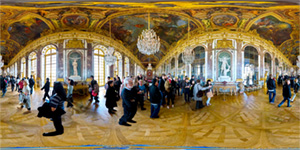
The Hall of Mirrors (La Grande Galerie) #1
Fullscreen
|
|
The Hall of Mirrors (La Grande Galerie) #2
The Hall of Mirrors (French:Grande Galerie or Galerie des Glaces) is the central gallery of the Palace of Versailles and is renowned as being one of the most famous rooms in the world.
The principal feature of this famous hall is the seventeen mirror-clad arches that reflect the seventeen arcaded windows that overlook the gardens. Each arch contains twenty-one mirrors with a total complement of 357 used in the decoration of the galerie des glaces. 2011-04-03
Show on map
|
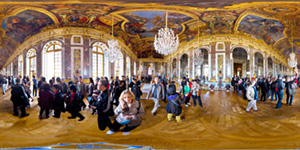
The Hall of Mirrors (La Grande Galerie) #2
Fullscreen
|
|
The Hercules Salon
The first salon of the King's Grand Apartment, the Hercules salon was created at the end of Louis XIV's reign. The works on the Hercules salon lasted until 1736, when Francois Lemoine completed the painting of the vault depicting the Apotheosis of Hercules, which was supposed to show that "Virtue raises man above himself". This vast allegorical composition with 142 figures aimed to rival the masterpieces of the Italian fresco painters but it was painted on primed canvases, i.e. glued onto the support. The work was so exhausting that the young painter, despite the success of his work, committed suicide shortly afterwards.
2011-04-03
Show on map
|
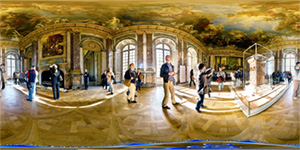
The Hercules Salon
Fullscreen
|
|
The Coronation Room
This large space adjoining the royal apartments first served as the palace's second chapel (1672-1682), and then the Great Guard's Room "for both the King and the Queen" (1682-1789). In 1833, it became a room devoted to the glory of Napoleon Bonaparte, First Consul and then Emperor of the French. The plan was to display the greatest paintings of his reign, which could not be placed anywhere else in the palace: the two immense paintings commissioned from Jacques-Louis David to commemorate the ceremonies celebrating Napoleon's crowning as Emperor of the French: The Coronation of 2 December 1804 (1805-1808), and The Distribution of the Eagle Standards on 5 December 1804 (1808-1810). The Palace of Versailles.
2011-03-13
Show on map
|
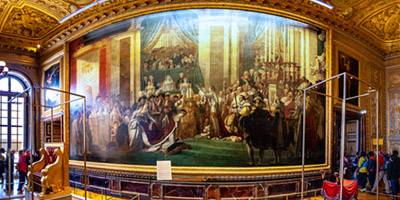
The Coronation Room
Fullscreen
|
|
The War Salon (Salon de la Guerre)
The decoration of the War Room (Salon de la Guerre) glorifies the military victories that led to the Peace of Nijmegen. The walls are covered with marble panels decorated with six trophies and gilded bronze carvings. The wall has an oval plasterwork bas-relief representing Louis XIV on horseback trampling over his enemies. It is surmounted by two gilded Renommées supported by two prisoners in chains. The ceiling represents France in the centre, armed and sitting on a cloud, surrounded by Victories. The ceiling panels portray the king’s three conquered enemies: Germany, kneeling, with an eagle; Spain, threatening, with a ro#229 lion and Holland, upside down on a lion. The fourth panel represents Bellone, Goddess of war, enraged between Rebellion and Discord. 2011-04-03
Show on map
|
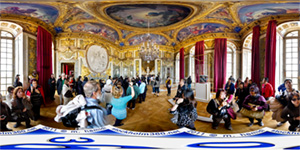
The War Salon (Salon de la Guerre)
Fullscreen
|
|
The Peace Salon (Salon de la Paix)
The Peace Room (Salon de la Paix) features the same decoration of marble panel and trophies of gilded bronze and carved weapons as in the War Room, to which is symmetrical. However, Le Brun decorated the cupola and the ceiling panels with the benefits of the peace given to Europe by France. 2011-04-03
Show on map
|
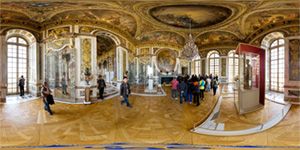
The Peace Salon (Salon de la Paix)
Fullscreen
|
|
The 1830 Room
The 1830 Room was the finishing touch on Louis-Philippe's galleries at Versailles when it was inaugurated in June 1837.
The decor commemorates the accession to power of Louis-Philippe, Duc d'Orléans, following the July 1830 Revolution, the "Three Glorious Days": first as lieutenant-general of the kingdom and, a few days later, as king "elected" by the French under the name Louis-Philippe I.
The Duc d'Orléans Arriving at the Hôtel de Ville in Paris" and "The Reading of the Proclamation of Deputies and the Proclamation of the Lieutenant-General of the Kingdom", "Louis-Philippe Taking the Oath before the Chambers to Uphold the Charter of 1830" and "The Flags of the National Guard Being Given to Paris" hang beneath the ceiling depicting "Truth Accompanying Justice and Wisdom, Protecting France from Hypocrisy, Fanaticism and Discord".
2011-04-03
Show on map
|
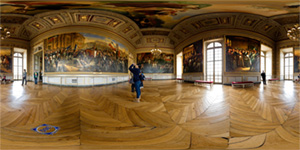
The 1830 Room
Fullscreen
|
|
The Hall of Battles
The Galerie des Batailles (Gallery of Battles) is a 120 metre long and 13 metre wide gallery occupying the first floor of the aile du midi of the Palace of Versailles, joining onto the grand and petit 'appartements de la reine'. It is an epigone of the Grande galerie of the Louvre and was intended to glorify French military history from the Battle of Tolbiac (traditionally dated 495) to the Battle of Wagram (5–6 July 1809). 2011-04-03
Show on map
|
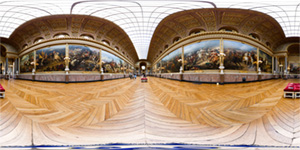
The Hall of Battles
Fullscreen
|
|
The Abundance Salon
On evening soirees, the Abundance Salon was the place of refreshments, where a buffet served coffee, wine and liqueurs. It was also the antechamber of the Cabinet of Curiosities or the Rarities of Louis XIV (now occupied by the Games Salon of Louis XVI) which was accessed by the rear door. The king liked to show his distinguished guests the silverware vases, gems and medals which were kept here and which inspired the decor of the vault, where one can see in particular the great royal vessel depicted above the doorway. 2011-04-03
Show on map
|

The Abundance Salon
Fullscreen
|
|
The Diana Salon
Like the Venus Salon, the Diana Salon served as a vestibule to the Grand Apartment and in Louis XIV's day, on evening soirees, as a billiard room. In Greek Antiquity, Diana, the goddess of hunting, was associated with the moon due to her coldness. She was also the sister of Apollo, the Sun God. The mouldings are decorated with hunting scenes of heroes of the Antiquity.
The central part of the ceiling represents Diana presiding over navigation and hunting. On the mantelpiece, the Sacrifice of Iphigenia and, opposite, over the console, Diana and Endymion.
2011-04-03
Show on map
|
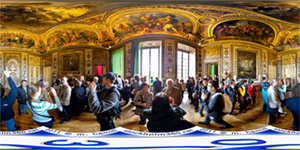
The Diana Salon
Fullscreen
|
|
The Mars Salon
Mars is a planet but also the God of War. The choice of this military theme which inspired all the decoration of the salon can be explained by the fact that this large room was originally meant to serve as the guard room for the parade apartment. It was later reserved, at evening soirees, for music and dancing, so that it was commonly known as the "ballroom".
In the centre of the ceiling, Mars on a chariot drawn by wolves. The work is framed by two compositions; one, to the east: Victory supported by Hercules followed by Abundance and Felicity; the other, to the west: Terror, Fury and Fright taking over the powers of Earth.
2011-04-03
Show on map
|
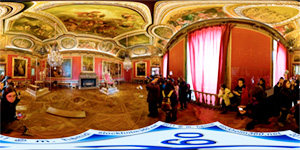
The Mars Salon
Fullscreen
|
|
The Venus Salon
This salon, as well as Diana’s Salon, formed the main access to the Grand Apartment, since the grand staircase, known as the "Ambassadors’ Staircase" (destroyed in 1752) ended here. Like all the following rooms, this salon takes its name from a planet, the theme linked to the solar myth which inspired all the decor of Versailles in the 1670s. Here Venus is depicted on the ceiling with the features of the Goddess of Love who, in Greek Antiquity, was associated with this planet. 2011-04-03
Show on map
|
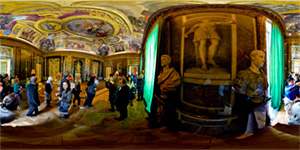
The Venus Salon
Fullscreen
|











